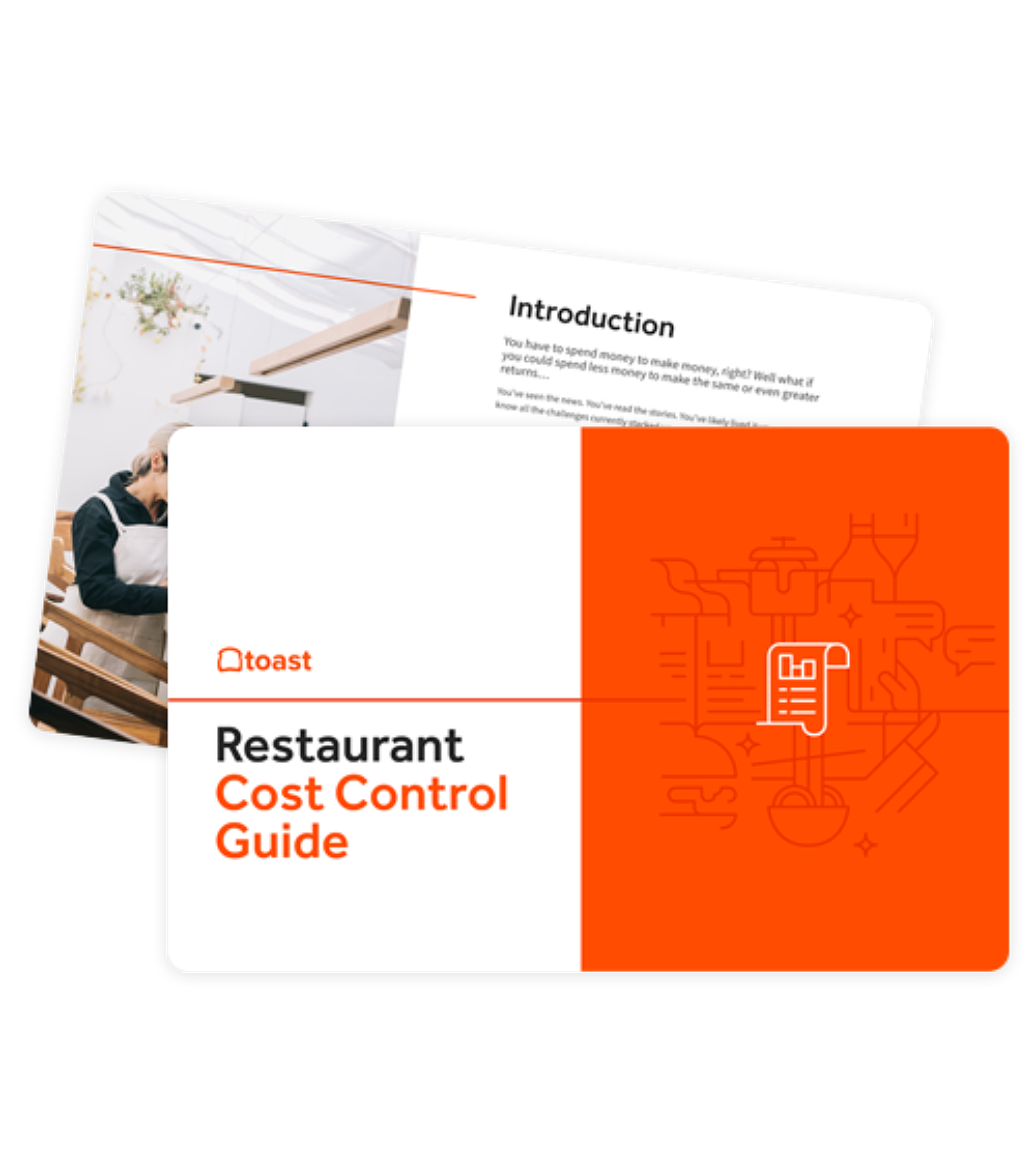
BEST Coffee Shop Inventory Management Software: How to Do Coffee Shop Inventory
Provide an inventory 101 with key terms, metrics, processes, and stakeholders — zooming in on any Coffee Shop-specific considerations, such as bulk coffee beans, pre-made vs in-house items, etc.
Grace JidounAuthor


Restaurant Cost Control Guide
Use this guide to learn more about your restaurant costs, how to track them, and steps you can take to help maximize your profitability.
Get free downloadHow often should coffee shops do inventory?
This depends on how often you have deliveries in your restaurant. Most restaurants do inventory check-ins 1 - 2 times per week, but it makes sense to take count of your inventory every time you’re restocking, to make sure that everything is fresh and within its expiration dates.
Coffee Shop Inventory Management Software: How to Do Coffee Shop Inventory
Coffee shop inventory management is just as complex as at a fancy restaurant or a corporate chain —especially in these days of economic uncertainty and ongoing food inflation.
Coffee continues to dominate the beverage sector. More Americans drink coffee in the past day (65%) than any other beverage. With such tremendous upside potential, it’s crucial to get inventory management right.
Read on to see how the coffee shop inventory approach can help improve profitability, reduce waste, and keep your coffee shop percolating happily along.
Restaurant Cost Control Guide
Use this guide to learn more about your restaurant costs, how to track them, and steps you can take to help maximize your profitability.

What is Coffee Shop Inventory Management?
Coffee shop inventory management is the process of making sure your inventory matches customer demand. The end goal is to maintain the perfect amount of inventory so that you don’t run out of a product nor end up with too much on the shelf or getting wasted.
Several terms are critical to understanding the world of coffee shop inventory include:
Cost of goods sold (COGS) is the cost of all the ingredients a coffee shop uses in a given time frame, such as coffee beans, sugar, food costs, and even the to-go cups and other paper supplies. To calculate your COGS, use this simple formula: Beginning inventory + Purchased inventory – Ending inventory. A general rule of thumb is that COGS should be around 25% of your total sales.
Par level refers to the minimum amount of supplies you should keep on hand to ensure you always meet your customers' needs.
Understanding plate costs is critical, and the first step is to track the unit of measurement that the ingredients were purchased in (ounces, pounds, gallons, cases, etc.). Plate costing is the difference between cost and price and is calculated using the formula: profit margin % = ([Price – Cost]/Price)*100.
Unit conversion involves converting ingredients between different units of weight and volume. For instance, you’ll need to know how to convert a bag of coffee beans to liquid volume.
The yield refers to the amount of usable product after processing. For example, a breakfast place that makes bacon in-house will see their raw pork belly weigh much more than its actual yield after curing and cooking.
The waste that occurs during beverage and food prep will also need to be factored into recipe costs.
The actual vs. theoretical formula (AvT) is the difference between the actual cost of goods sold and the theoretical (or expected) cost of goods sold based on projections from historical data. This is also known as variance.
Depletion measures how long you have a product until it is entirely gone.
The count sheet is the spreadsheet you use to keep track of your physical inventory.
Shelf-to-sheet inventory tracking is looking at what’s on your shelf and matching it to your inventory sheet.
Shrinkage means you have less inventory on your shelves than what you’ve recorded in your books. This red flag often signals theft, shoplifting, or fraud.
Why inventory management matters
Intentionality is the name of the game for coffee shop inventories — and it requires accurate, timely information. Everything from stirrers to filters to the caramel drizzle needs to be counted and tracked so coffee shop managers can accurately calculate the costs of each item sold.
A strong coffee shop inventory management system will help operators understand exactly what supplies are coming in, what was left unused, and what was wasted along the way.
Manual inventory management vs. coffee shop inventory management system
Many operators count their shops’ stock entirely by hand. Armed with only their coffee shop inventory spreadsheet, they and/or their team spend countless hours ticking off gallons of milk, assessing the sugar packet supply, and marking down the number of unsold bagels at the end of the day.
While “shelf-to-sheet” is a tried-and-true method, it’s easy for errors to sneak in. It’s also not the most efficient approach to coffee shop inventory management especially for larger businesses.
With so much to consider, from the cost of goods sold to determining par inventory, many business owners turn to inventory management software and automated invoicing to improve the process. There has been a recent surge of innovation in coffee shop inventory management systems.
For instance, a POS system will centralize sales, inventory, payment, and customer and marketing data all in one dashboard. You can save time, reduce errors, and avoid major headaches with the right coffee shop inventory system.
The most effective approach is often a blend of old-school hands-on methods with newer automated software. It’s all about finding balance. The industry hasn’t done away with hands-on counts quite yet. However, many owners, operators, and managers don’t like nor have the time for the drudgery of invoice processing — this is where invoice automation truly shines.
You can learn more about invoice automation systems and see how these tools provide an excellent foundation upon which to optimize your inventory practices.
Whether your approach to coffee shop inventory is manual or automated (or a mix of the two), an excellent place to start is our Restaurant Cost Control Guide, where we share best practices, helpful tips, and industry insight into the tricky business of keeping costs down. We’ll also walk you through setting up an inventory management system with a series of Par Inventory Excel Spreadsheets.
Best practices for coffee shop inventory management
With more than 70,000 coffee and snack shops in the U.S. (according to 2022 data from IBISWorld), there is a wealth of information at our fingertips about best practices.
Coffee shop inventory management is a tricky process, so laying a solid foundation is crucial. After brushing up on accounting basics with our helpful guide, consider the following advice:
Take inventory often. When you factor in perishable items and the fickle tastes of customers, it’s essential to count your coffee shop inventory regularly to ensure it matches what you think you have. Depending on your type of coffee shop and how many customers typically line up for daily lattes, this could be once a week, once a day, or even spot-checks throughout the day. Regardless of how often you do it, taking inventory should be a top priority.
Organize your space. Being organized is critical to keeping accurate inventory lists. It also boosts the productivity of your staff, so they can easily find the products they need to serve customers. The number one tip from Andrew Atkin, co-owner of KAFN Coffee Bar in Glendale, CA, is to anticipate growth, both in terms of new products and physical storage space. “We were trying to stay minimalistic when we first opened and served espressos, mochas, and maybe a vanilla latte. But we quickly learned our flavored lattes sold better than anything else. Our non-dairy needs, like oat milk, grew exponentially too.” He quickly expanded the menu, which meant new suppliers, new inventory, and new ideas on how to store all those products. While this is just one coffee shop inventory example, expecting the unexpected is always wise.
Maintain a consistent inventory schedule. Taking inventory at the same time each day will help you better understand the demands for specific products. You’ll understand what ingredients are used and when so that you can adjust accordingly on future orders. You might notice that double espresso shots spike on Mondays, and pumpkin lattes are more of a weekend indulgence.
Train your staff. We talk so much about automation and software, but your employees are perhaps the most important part of your coffee shop inventory management system. Larger businesses may designate an employee or manager to handle inventory. At KAFN, Atkin asks all staff members to add to a whiteboard “shopping list.” “They’re in the trenches, so team communication is important. I might not notice that our basket of Pump Street Chocolate bars is low, but one of my employees will see that and put it on the whiteboard. It makes our team more cohesive.” For Atkin, it’s essential to cultivate a team that feels invested in the business, not just from a customer service standpoint but also to ensure consistency and avoid miscommunication.
Invest in Restaurant Inventory Management Software
Operating a coffee shop is an exciting endeavor. You create relationships with locals and invent tantalizing new drinks, not to mention you’re surrounded by the delightful aroma of freshly-roasted coffee all day. An investment in software may be the last thing on your mind. But a robust coffee shop inventory management system, such as xtraCHEF by Toast, will help you make better business decisions and ultimately keep your customers happy.
The single most crucial step you can take is to digitize invoices; it is the foundation on which all profitable inventory processes are built. Digital invoices can help dramatically cut costs simply by eliminating human error.
There’s nothing worse than waking up in the middle of the night to realize you added an extra “zero” to an invoice or missed a payment on an important bill — heaven forbid it’s from your coffee bean supplier. Integrating inventory into the invoice automation process means worries over duplicate payments, late payments, or missed bills will be a thing of the past.
To get the most out of your software investment, it’s also essential to define your product catalog so that it can be integrated into your inventory management system. A digital product catalog will allow you to monitor in-store and online sales better and make tracking certain metrics easy, from shrinkage to popular menu items.
One coffee shop inventory example is the baked goods case. If a certain almond croissant is flying off the shelves, you’ll know when to order more in real time. If your signature bialy sells out online, you can quickly set them aside for pickup. The information gleaned about your coffee shop inventory will be invaluable. You can use it to manage your product mix better and faster, ditching the mushroom coffee on your menu for vanilla chai instead.
Additionally, inventory software will help you master the elusive concept of par leveling, the goal of every company everywhere. The data you capture will help you to accurately forecast demand for your products to keep everyone happy. Your customers will blissfully enjoy their caffeinated treats, and you’ll cut down on waste and maximize inventory profitability.
Whether you’re seeking a simple, intuitive system or a complex suite of products with all the bells and whistles, the right automated inventory tools are within reach. Think of inventory management software as a financial assistant that has your back, helping to control food costs and maximize margins so you can focus on the fun stuff.
Manual restaurant inventory management
Some operators take restaurant inventory the old way. They use printouts and write down the numbers of every single item, including UOMs. Then, they transfer that information into an Excel spreadsheet or an outdated legacy system that hosts inventory count sheets.
The process up to this point is already cumbersome — and it just gets worse.
Managers, chefs, or other assigned employees will then check for consistency of UOMs and refer to invoices for relevant costs. If different suppliers have different UOMs, conversions must be made.
The manual way of taking inventory clearly takes up a lot of time and is prone to human error. Imagine what you and your employees could do with all that extra time. You could chat with guests to gather feedback, refine your digital marketing approach, create new menu items…the possibilities are endless.
Inventory Management Software
Technology can help eliminate a lot of the manual input, errors, and paper-pushing by digitizing paper invoices and automatically pulling invoice data into cloud-based restaurant management software.
While someone in your restaurant(s) will always need to get hands-on inventory counts on a regular basis, there are ways to do it beyond pen and paper.
Accurate and efficient inventory counts require scheduling, organization, and should pull information from recent invoices. This way you have an idea of what’s on-hand. The value here is eliminating as much human error as possible, including the products being counted, their location, and recording actual counts.
This means you can see what your on-hand inventory levels are in real time, based on your latest supplier prices. Your COGS numbers will be more accurate, so you’ll make better decisions. And because the human element is removed, you can feel confident that there are no errors.
Some software even automatically applies General Ledger (GL) codes. These codes are part of your restaurant accounting best practices and are vital if you want to improve efficiency and reduce food costs.
Simply put, business owners create these codes to help categorize transactions and make them easily searchable in the restaurant Chart of Accounts, a record of all the financial transactions your restaurant has ever made. They keep your ledger tidy and audit-ready.
Furthermore, the software can also simplify your entire inventory management process by:
- Prompting inventory counts. Just set the frequency, time of day, and assign a staff member to take inventory.
- Letting you manage inventory via mobile apps, even if you have no Wi-Fi deep inside the walk-in. Simply sync up to the Wi-Fi when you have internet access again, and counts will update automatically.
- Making it easy to build count sheets by creating a product catalog from digitized invoices. Historical prices update automatically, so you don’t have to dig through old invoices to find previous pricing, and you can drag and drop new products into existing count sheets when needed.
- Ensuring your inventory levels are up to par. Simply select your par levels when using the system for the first time. Then, after you’ve taken inventory, watch how the software automatically generates order guides based on what you have available and what you need to maintain par. It’s that simple.
Of course, not all software is created equal — and often, restaurant operators find they need to invest in multiple platforms for better inventory management: one for inventory automation and another for managing inventory.
You end up flipping between platforms and having to revert back to manual data entry and double-checking figures. Software that was supposed to make your life easier is now doing the exact opposite.
FAQs
How often do restaurants do inventory?
This depends on how often you have deliveries in your restaurant. Most restaurants do inventory check-ins 1 - 2 times per week, but it makes sense to take count of your inventory every time you’re restocking, to make sure that everything is fresh and within its expiration dates.
How is food cost calculated?
Food cost percentage is calculated by taking the cost of goods sold and dividing that by the revenue or sales generated from that finished dish. Learn more about calculating food cost percentages here.
How much food inventory should a restaurant carry?
You only need to have enough inventory to cover your sales, plus a little bit extra in case of an emergency. For most restaurants, this usually means about 5 - 7 days worth of inventory, if you’re getting 1 - 2 deliveries per week.
What is a good inventory to sales ratio?
A good inventory to sales ratio is between 4 and 8, which means selling your entire food inventory between four and eight times each month.
What is the average inventory turnover ratio for restaurant food?
The inventory turnover ratio indicates the number of times the store sold out its inventory in a given time period. A low inventory turnover ratio indicates either low sales or too much inventory in stock, while a high inventory turnover ratio indicates either strong sales or a poor inventory purchasing plan. The restaurant industry average is about five.
Par Inventory Sheet Template
Seamlessly track inventory with the help of this customizable par inventory sheet template.

Is this article helpful?
DISCLAIMER: This information is provided for general informational purposes only, and publication does not constitute an endorsement. Toast does not warrant the accuracy or completeness of any information, text, graphics, links, or other items contained within this content. Toast does not guarantee you will achieve any specific results if you follow any advice herein. It may be advisable for you to consult with a professional such as a lawyer, accountant, or business advisor for advice specific to your situation.
Read More
Subscribe to On the Line
Sign up to get industry intel, advice, tools, and honest takes from real people tackling their restaurants’ greatest challenges.


